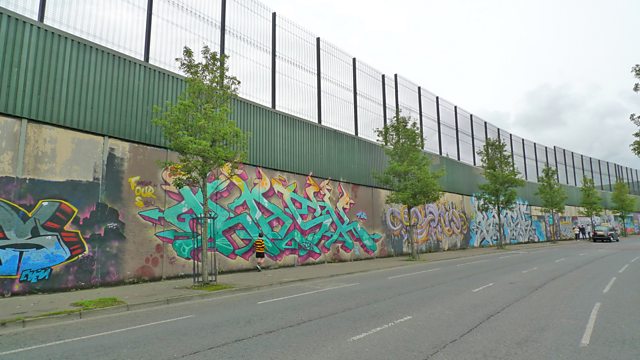| The Berlin Wall, April 18, 1967 rarehistoricalphotos.com |
Do walls affect the way we think? By that Blogger means do walls traumatize the people they are meant to keep in or keep out? Consider the 1962 case of an East German woman who suffered locked jaw in a psychiatric clinic in Leipzig. Weeks before, she has an infected wisdom tooth removed; as routine as this may sound, the doctors were baffled about her condition. They described her condition as "despondent and excitable" (newyorker.com; Mar. 28, 2019; date accessed Apr. 9, 2019). A short time later, the woman became suicidal.
In the late sixties, German psychiatrist Dietfried Muller-Hegemann noticed an uptick in similar inexplicable cases such as dentist waiting on the shores of the Baltic Sea for a boat to take him to China; a civil servant who claimed that he was being spied upon; and a seamstress thought lesbians were following her (Ibid). These and other cases had one thing in common, all of the patients lived close to the Berlin Wall. In his 1973 book, Dr. Muller-Hegemann gave this strange phenomena a name: Mauerkrankheit--wall disease (Ibid).
A few years ago, Aideen Maguire, an epidemiologist at Queen's University in Belfast, North Ireland, wondered whether the peace lines--the barriers that separated Roman Catholics and Protestants during the Troubles--might be a factor in the country's plethora of mental health issues. Ms. Wapner notes, "According [mentalhealth.org.uk; date accessed Apr. 9, 2019] to the Mental Health Foundation, a U.K. charity organization, Northern Ireland is reported to have a 25% higher overall prevalence of mental health problems than England" (newyorker.com; Mar. 28, 2019). Dr. Maguire compared the locations of the peace lines to the health records of a million citizens. She concluded that people living near barrier were 19 percent more likely to be on antidepressants and 39 percent more likely to take anti-anxiety medication (Ibid). "Even those who grew up after the conflict was resolved experienced these effects" (Ibid). In an article published in the 2016 issue of Journal of Epidemiology and Community Health (jech.bmj.com), Dr. Maguire and her co-authors wrote, Living in an area segregated by a 'peaceline is detrimental to mental health.
 |
| Along the peacelines Belfast, Northern Ireland bbc.co.uk |
Everything would suggest that they're not any different from the reset of the study population,..., except for the fact that they have a wall at the end of their street (newyorker.com; Mar. 28, 2019)
In the sixties, Dr, Muller-Hegemann "wrote as though the physical presence of the Berlin Wall were itself the cause of wall disease" (Ibid). However, most contemporary psychologists who devote their time to border studies see an abstract relationship between the barriers and mental health. Cornell University sociologist Christine Leuenberger told The New Yorker "that barriers are best thought of as a part of a 'wall-system'" (Ibid). The wall-system includes physical landmarks such as no-go zones, checkpoints, and ripple effects like job loss and the breakdown of social networks.
Ms. Leuenberger recalled meeting with a Palestinian man in Bethlehem, near the West Bank barrier. The gentleman worked as a nurse in Jerusalem but could no longer travel to the Israeli side for work and resorted to selling soda by the roadside. Before the barrier went up, Israelis and Palestinians freely traveled between the Green Line for shopping and work. An effort to create a border market stopped when the barrier went up. "In this straightforward sense, walls can cut people off from sources of stability and happiness...." (Ibid)
 |
| U.S.-Mexico border checkpoint San Ysidro, California kpbs.org |
Returning to Northern Ireland, the Troubles are long over and lawmakers are considering removing the peace lines. Strangely, public sentiment is not completely behind the proposal: "a 2012 survey of eight hundred and forty people who live near them found that only forty-four per cent agreed with statement, I would like things left the way they are now" (Ibid). Aideen Maguire grew up outside of Belfast and believes "that the peace lines have become both a source of fear and 'a security blanket' to assuage it" (Ibid). The continued presence of brick existence of brick walls and concrete barriers, invading domestic spaces reinforces the notion of "the other"--Protestant versus Catholic--keeping the fear alive.
 |
| Southwest Key Program child detention center Brownsville, Texas cnn.com |
The mental illness related to the wall is also related to the surveillance that goes with it (Ibid).
The constant surveillance is part of the dystopic environment that walls engender.
A few years ago, University of Groningen in the Netherlands public health researcher Tobia Vogt, set out to determine if the fall of the Berlin Wall extended life expectancy. Mr. Vogt compared the life expectancy of former East Germans if the wall had not come down with their current lifespan. The study was published in the 2013 issue of Gerontology (karger.com; 2013; date accessed Apr. 15, 2019). Mr. Vogt found that after reunification, East German women lived four years longer and the men lived six years longer.
Tobias Vogt stressed, "...this dramatic difference is likely due to improved health care and higher standard of living, not to the disappearance of the wall, as such" (newyorker.com; Mar. 28, 2019). After the Berlin Wall came down, people sixty and over--the age group that showed this dramatic extensions--had better access to medical care. However, Mr. Vogt believes that freedom from oppression was also a factor. He said,
A feeling of liberty, opportunities to travel all contributed to the well-being of East Germans,...(Ibid)
He is proof of that. As child in East Germany, he collected maps of the world, believing that he would never have the chance to visit countries like Greece and India. He spoke to The New Yorker from India adding, For me, this is a great gift,...I'm always grateful that the wall came down (Ibid). Mr. Vogt is currently studying whether children born post-Reunification show (i.e. after 1989) demonstrate better cognitive development than children born before Reunification.
Although the Berlin Wall is just a tourist stop, its presence continues to cast a long shadow. In the years following Reunification, German psychologists discovered a new syndrome replacing wall disease: die Mauer in den Kopfen ("the wall in the head; Ibid). University of Bamberg psychologist studying perception Claus-Christian Carbon conducted a study on eighty-three people. In his study, he asked his subject to estimate the distance between ll German cities; all in different states. Six of the cities were east of the wall and five were west of it. His study was published in 2005 in Psychonomic Bulletin & Review (link.springer.com; Aug. 2005; date accessed Apr. 15, 2015). The subjects in the study "consistently overestimated the distances between cities that had once been on opposite sided of the barrier. Participants who disliked reunification performed the worst, believing that formerly East German cities were much farther away from formerly West German cities than they really were" (newyorker.com; Mar. 28, 2019).
Mr. Carbon told The New Yorker in an email, Psychology is very often stronger than physics,.... (Ibid). The results were in sync with his anecdotal observations: "though the wall is gone, Berlin drivers often follow inefficient routs to avoid areas where it once stood. Elisabeth Vallet added, Even if border walls end up falling, they stay in the minds of people (Ibid). In essence, tear down the wall and its ghost haunts.
 |
| Israel-Palestine separation wall middleeastmonitor.com |
Jessica Wapner writes, "In 1969, the British psychoanalyst Donald W. Winnicott called the Berlin Wall a manifestation of a 'manica-depressive psychosis.'" (Ibid) He argues that the wall "allowed Germans to postpone resolution of their internal conflict" (Ibid). He wrote,
Exactly at this spot is the place where if there is no wall there is war (Ibid)
The peace barriers in Northern Ireland had a similar goal: mitigating the violence that left thousands dead. Israeli psychologists told Christine Leuenberger "that the security barrier makes the Palestinians invisible." She said,
It makes a problem that people don't want to deal with go away (Ibid)
The murals painted on border walls heighten the mirage effect.
Turkish Cypriot psychiatrist Vamik Volkan added, Basically, their purpose is psychological protection (Ibid). Mr. Volkan specializes on international relations of border walls. He continued, "The structures promise to answer the question, Who are we now? (Ibid) Be that as it may, they are a psychological illusion (Ibid). Often, emphasizing and aggravating the identity crises they were intended to resolve.
However, creating a permanent sense of crisis may be exactly what wall builders hope to accomplish. When Elisabeth Vallet conducted her global inventory, she found that walls were built for three main reason: "establishing peace; preventing smuggling and terrorism; stopping immigration" (Ibid) Nearly fifty of the barriers put up since 2002 were designed to the latter: keep "the other" out, whoever the designated "other" is at the moment. History has shown that a political agenda founded on nationalism is fueled by paranoia and suspicion regarding the true motives of foreigners. Jessica Wapner observes, "Arguably, the mental-health problems that walls exacerbate also benefit nationalist leaders" (Ibid). History has also proven that despondency can diminish the ability to resist; depression and anxiety can affect the way we vote. As citizen numb themselves to the inhumane treatment of detainees, the less likely they fight a political leader who uses fear of "the other" as part of a political platform. The siege mentality is what creates the physical barrier. Once built, those living in its shadow become more besieged.
No comments:
Post a Comment